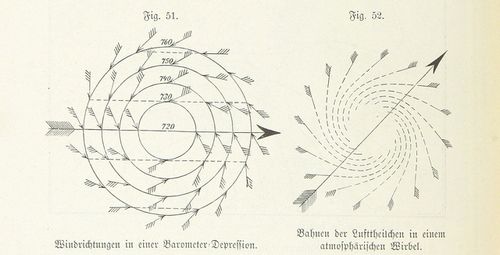Earlier in the year, we invited individuals working with sound to compose a short audio piece inspired by one of the million 17th, 18th and 19th Century images released by the British Library onto Flickr Commons. The challenge was taken up by a number of artists, who found inspiration in images related to geology, science fiction, exploration and mechanics.
French sound artist and composer Stéphane Marin (aka Espaces Sonores), rather than focus on one particular image, chose instead to create a series of compositions based around the theme of the four elements - air, earth, fire and water. Air is the subject of the first instalment in this series and takes its inspiration from an image published in the 1886 monograph 'Our Knowledge of the Earth: general geography and regional studies' by the German geographer and naturalist, Alfred Kirchoff.
Part 1 - Inspired by Air
Reverie has four areas, four arrows with which she ran in infinite space.
To force the secret of a true poet [...], a word is enough: "Tell me what's your ghost?
Is it the Gnome, the Salamander, the Mermaid or the Sylph? "
Gaston Bachelard - The Psychoanalysis of Fire
Discovered during my studies in philosophy, Gaston Bachelard never ceases to invigorate my mind, sharpen my listening attention, wake up my reveries ... He accompanies each of my creations, which always begin with the ever inspiring reading of his poetry and elementary psychoanalysis. Allow me to choose him to escort us all along this elementary sound quadrilogy.
While I was producing street art soundworks 'for', 'in' and 'with' public spaces, so many dust particles and rain drops, agitated by wind bursts, fell on to my computer screens, my microphone diaphragms and sound cards connections, not to mention the frequent sunburn....The "weather fluctuations" (in a pragmatic sense), also called "Elementary Forces of Nature" (in a more lyrical sense), are the incoercible factors which (dis-)orientate every day the work of the outdoor composer. But better to go with these forces, instead of fighting against them in vain.
These may be, beyond the pure fascination imposed by natural phenomena, some of the reasons which also forced me to open up a bit more, every day, my attention to elementary environmental sounds. To create, sometimes, enough transparency to let them be heard in their most naive and bare manifestations, but never without an inch of genuine or fictive drama.
1_AIR :
//////// inHALE...
The Poet breathes in the world:
"The bleat, the bark, bellow, and roar,
Are waves that beat on heaven's shore."
W. Blake, Auguries of Innocence - The Pickering Manuscript
exHALE ! ////////
The Philosopher breathes out the poet :
"The wind, in its excess,
is the anger that is everywhere and nowhere,
that is born and reborn of itself,
which rotates and overturns. "
G. Bachelard - Air and Dreams:
An Essay on the Imagination of Movement
//////// inHALE...
Microphones breathe in the time of a space.
Raw energy, this excessive wind,
came banging at my window on a winter morning.
exHALE ! ////////
Speakers breathe out the trace, the elemental ghost of that moment ...
Like any anger requires a breathing space to afford a lull.
//////// inHALE...
This monograph invites us to gather all these swirling sources to two clear and distinct directions.

exHALE ! ////////
As binaural stereo facilitates the drainage of ardent energy flow to brittle ear canals
1_MATIN_D_ARIEGE
Fin
Such a variety of visual content was included in Kirchoff's monograph, from images of wildlife and natural landscapes to maps and meteorological charts. For reasons known only to our artist however, it was the above image that caught his eye and inspired his mind.
Earth will be the subject of our next Inspired by Flickr elemental series, so keep an eye and an ear out for that!
------------------------------------------------------------------------------------------
Following many collaborations with street art companies (Allegro Barbaro / Le Phun / Osmosis Cie / 2ème Groupe d'Intervention / Décor Sonore) on projects performed in the six corners of the French hexagon, and in international festivals held in cities such as Suwon, Beirut, Poznan, Grätz, Valladolid, Manchester and Saarbrüken, Stéphane Marin created Espaces Sonores in 2008, a company dedicated to contextual sound creation and sound art. His work includes An Umbrella for 2 - audio walks to be shared by two people under an umbrella which was created for the Saint Charles train station in Marseille (Lieux Publics - Street Arts Creation National Center) and the streets and underpasses of Singapore (Singapore Arts Festival - National Arts Council), Elementaire - an ecological soundscape for relaxing sound naps ; ÉcoutesS d'EspaceS / EspaceS D'écouteS sound walks, sessions of yoga for your ears and finally contributions to events that help others rediscover the pleasures of phonography (Mingalabar ! - Arte Radio - Paris / L'Oreille Nomade #1 - Myanmar - Kinokophonography @ New York Public Library for Performing Arts).